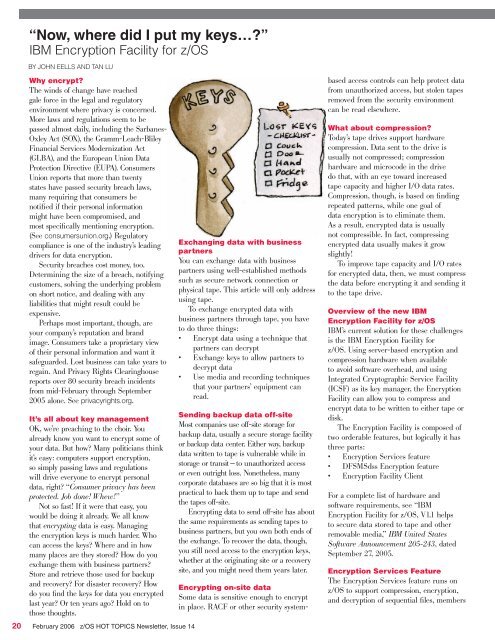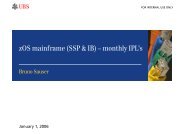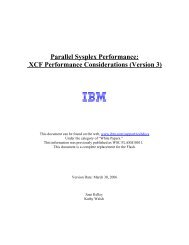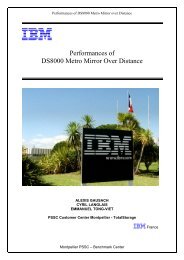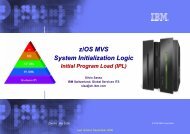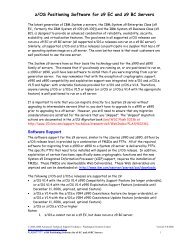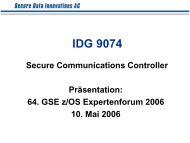Hot Topics - Messmer The Brain House
Hot Topics - Messmer The Brain House
Hot Topics - Messmer The Brain House
Create successful ePaper yourself
Turn your PDF publications into a flip-book with our unique Google optimized e-Paper software.
“Now, where did I put my keys…?”<br />
IBM Encryption Facility for z/OS<br />
BY JOHN EELLS AND TAN LU<br />
Why encrypt?<br />
<strong>The</strong> winds of change have reached<br />
gale force in the legal and regulatory<br />
environment where privacy is concerned.<br />
More laws and regulations seem to be<br />
passed almost daily, including the Sarbanes-<br />
Oxley Act (SOX), the Gramm-Leach-Bliley<br />
Financial Services Modernization Act<br />
(GLBA), and the European Union Data<br />
Protection Directive (EUPA). Consumers<br />
Union reports that more than twenty<br />
states have passed security breach laws,<br />
many requiring that consumers be<br />
notified if their personal information<br />
might have been compromised, and<br />
most specifically mentioning encryption.<br />
(See consumersunion.org.) Regulatory<br />
compliance is one of the industry’s leading<br />
drivers for data encryption.<br />
Security breaches cost money, too.<br />
Determining the size of a breach, notifying<br />
customers, solving the underlying problem<br />
on short notice, and dealing with any<br />
liabilities that might result could be<br />
expensive.<br />
Perhaps most important, though, are<br />
your company’s reputation and brand<br />
image. Consumers take a proprietary view<br />
of their personal information and want it<br />
safeguarded. Lost business can take years to<br />
regain. And Privacy Rights Clearinghouse<br />
reports over 80 security breach incidents<br />
from mid-February through September<br />
2005 alone. See privacyrights.org.<br />
It’s all about key management<br />
OK, we’re preaching to the choir. You<br />
already know you want to encrypt some of<br />
your data. But how? Many politicians think<br />
it’s easy: computers support encryption,<br />
so simply passing laws and regulations<br />
will drive everyone to encrypt personal<br />
data, right? “Consumer privacy has been<br />
protected. Job done! Whew!”<br />
Not so fast! If it were that easy, you<br />
would be doing it already. We all know<br />
that encrypting data is easy. Managing<br />
the encryption keys is much harder. Who<br />
can access the keys? Where and in how<br />
many places are they stored? How do you<br />
exchange them with business partners?<br />
Store and retrieve those used for backup<br />
and recovery? For disaster recovery? How<br />
do you find the keys for data you encrypted<br />
last year? Or ten years ago? Hold on to<br />
those thoughts.<br />
20 February 2006 z/OS HOT TOPICS Newsletter, Issue 14<br />
Exchanging data with business<br />
partners<br />
You can exchange data with business<br />
partners using well-established methods<br />
such as secure network connection or<br />
physical tape. This article will only address<br />
using tape.<br />
To exchange encrypted data with<br />
business partners through tape, you have<br />
to do three things:<br />
• Encrypt data using a technique that<br />
partners can decrypt<br />
• Exchange keys to allow partners to<br />
decrypt data<br />
• Use media and recording techniques<br />
that your partners’ equipment can<br />
read.<br />
Sending backup data off-site<br />
Most companies use off-site storage for<br />
backup data, usually a secure storage facility<br />
or backup data center. Either way, backup<br />
data written to tape is vulnerable while in<br />
storage or transit—to unauthorized access<br />
or even outright loss. Nonetheless, many<br />
corporate databases are so big that it is most<br />
practical to back them up to tape and send<br />
the tapes off-site.<br />
Encrypting data to send off-site has about<br />
the same requirements as sending tapes to<br />
business partners, but you own both ends of<br />
the exchange. To recover the data, though,<br />
you still need access to the encryption keys,<br />
whether at the originating site or a recovery<br />
site, and you might need them years later.<br />
Encrypting on-site data<br />
Some data is sensitive enough to encrypt<br />
in place. RACF or other security system-<br />
based access controls can help protect data<br />
from unauthorized access, but stolen tapes<br />
removed from the security environment<br />
can be read elsewhere.<br />
What about compression?<br />
Today’s tape drives support hardware<br />
compression. Data sent to the drive is<br />
usually not compressed; compression<br />
hardware and microcode in the drive<br />
do that, with an eye toward increased<br />
tape capacity and higher I/O data rates.<br />
Compression, though, is based on finding<br />
repeated patterns, while one goal of<br />
data encryption is to eliminate them.<br />
As a result, encrypted data is usually<br />
not compressible. In fact, compressing<br />
encrypted data usually makes it grow<br />
slightly!<br />
To improve tape capacity and I/O rates<br />
for encrypted data, then, we must compress<br />
the data before encrypting it and sending it<br />
to the tape drive.<br />
Overview of the new IBM<br />
Encryption Facility for z/OS<br />
IBM’s current solution for these challenges<br />
is the IBM Encryption Facility for<br />
z/OS. Using server-based encryption and<br />
compression hardware when available<br />
to avoid software overhead, and using<br />
Integrated Cryptographic Service Facility<br />
(ICSF) as its key manager, the Encryption<br />
Facility can allow you to compress and<br />
encrypt data to be written to either tape or<br />
disk.<br />
<strong>The</strong> Encryption Facility is composed of<br />
two orderable features, but logically it has<br />
three parts:<br />
• Encryption Services feature<br />
• DFSMSdss Encryption feature<br />
• Encryption Facility Client<br />
For a complete list of hardware and<br />
software requirements, see “IBM<br />
Encryption Facility for z/OS, V1.1 helps<br />
to secure data stored to tape and other<br />
removable media,” IBM United States<br />
Software Announcement 205-243, dated<br />
September 27, 2005.<br />
Encryption Services Feature<br />
<strong>The</strong> Encryption Services feature runs on<br />
z/OS to support compression, encryption,<br />
and decryption of sequential files, members


